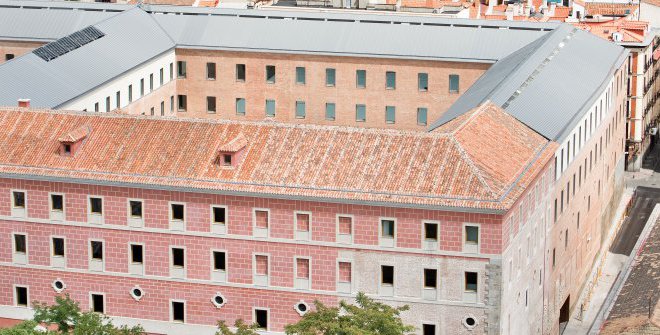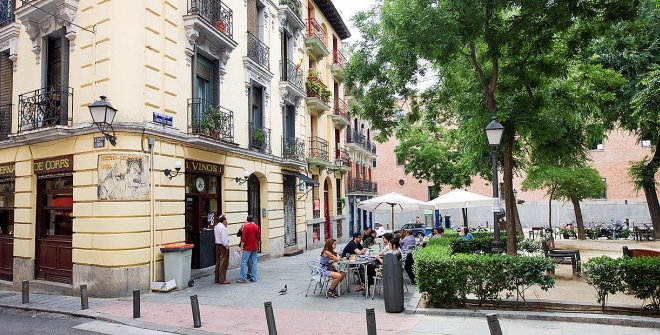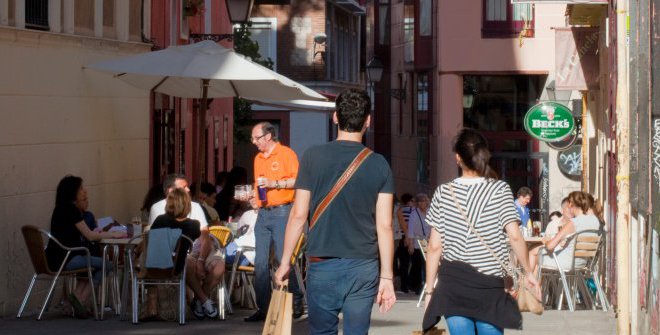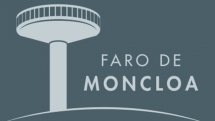Conde Duque
Around the old Conde Duque military quarters, a district with narrow streets, traditional taverns and original stores
 01_1407312311.48.jpg
01_1407312311.48.jpg 02_1407312316.725.jpg
02_1407312316.725.jpg 03_1407312321.647.jpg
03_1407312321.647.jpg 04_1407312325.699.jpg
04_1407312325.699.jpg 05_1407312330.844.jpg
05_1407312330.844.jpg 06_1407312335.432.jpg
06_1407312335.432.jpg 07_1407312339.836.jpg
07_1407312339.836.jpg

- Info & history
- Art & culture
- Shopping
- Food & drink
- Noche
Conde Duque developed around the old military quarters bearing the same name. Joyful, bohemian and spontaneous, it has newly created, modern stores with a vintage twist. Unlike its noisier southern borders, Gran Vía, Plaza de España and Calle Princesa, Conde Duque is a quiet and peaceful neighbourhood.
The full name of the huge Conde Duque quarters is Royal Bodyguards Quarters, an elite military unit whose members were the guards of the kings and queens of Spain. In 1717, the first Bourbon king of Spain, Philip V, appointed the prestigious architect from Madrid Pedro de Ribera to build the military complex. On the 200m-long frontage, the stone façade in the Churrigueresque style facing the square is quite remarkable.
The Conde Duque centre is currently one of the city’s largest cultural expression centres, along with Matadero and CentroCentro. Following its renovation, completed in 2011, it is home to the City’s Archives, the Municipal Depository, the Municipal Historical Library, the Museum of Contemporary Art, which displays the office of Ramón Gómez de la Serna and the Víctor Espinós Musical Library, created for the diffusion and promotion of musical education. All of this is accompanied by exhibition halls, an auditorium and various stage spaces.
Walking around this area of Madrid, you come across a lot of historical churches, palaces, art galleries and even the Museo de dibujo e ilustración (Drawing and Illustration Museum).
This spectacular palace was built in 1773 to a design by Ventura Rodríguez and other renowned architects of the time. It’s the Madrid residence and home of the foundation of the House of Alba, one of Spain’s most preeminent noble families. The palace contains a celebrated private art collection, including great works of art like the Portrait of the Grand Duke of Alba, by Titian, and the Portrait of the 13th Duchess of Alba, by Goya. The palace offers a guided visit service which includes, entrance to one of the most unique and attractive rooms of this residence, the Library, which until now, has only been open to academics and researchers.
The ABC Museum opened its doors in 2010, housing the first Mahou brewery. The museum is home to the ABC Collection, one of the largest collections of illustrations in the world, declared an Asset of Cultural Interest. The Clara del Rey Municipal Cultural Centre has been located in the same building as the museum since 2023. In March 2024, the museum reopened its doors to showcase once again the richness of its collections, composed of 150,000 works by 500 artists along with temporary exhibitions.
Clara del Rey Cultural Centre - ABC Museum
This cultural space is housed in an old brewery whose metal and glass façade is as attractive as are the original illustrations and drawings inside. All of them are works of famous artists which appeared in the newspaper ABC and the magazine Blanco y Negro.
The nunnery of the Military Order of Santiago was founded by King Philip IV in 1650. The remarkable church has a Greek-cross plan, with a crossing crowned by a beautiful dome, supported by chamfered columns.
The palace was built in the eighteenth century as the home of the Marquises of Guadalcázar. In the late nineteenth century, it was acquired by the Bauers, a family in the banking business. In the first 25 years of the twentieth century, it was the centre of the musical life of the city, and today it’s the site of Madrid’s Higher Singing College.
Church of Nuestra Señora de Montserrat
The church of Montserrat was founded by the Benedictine monks who fled the Montserrat monastery in Barcelona in 1640. The works on the church were abandoned in 1720 and they were never finished. Sebastián Herrera Barnuevo was in charge of the church’s original design, even though after his death other architects took over.
Considered as one of his best works, the architect Ventura Rodríguez was buried there alongside his wife but was later relocated to the architect’s chapel in San Sebastián parish. The simple exterior does not prepare you for the ornamented walnut-wood interior and its splendid organ.
Conde Duque is also one of the neighborhoods with numerous art galleries. Blanca Berlín Galería or Twin Gallery are some of the famous galleries located there.
Fundación Casa de México en España
This early 20th century palace is home to this centre that serves as a bridge for cultural exchange and knowledge transfer between Mexico and Spain. It forms part of the Mexican Embassy and houses the “Martín Luis Guzmán”, Economic Culture Fund bookshop, an auditorium, a shop specialised in popular art and exhibition halls. The foundation also has a restaurant, Puntarena, which proposes an authentic reinterpretation of coastal food, with the best Mexican dishes that showcase the freshness and flavour of sea food.
The shopping itinerary in Conde Duque doesn’t pass by big department stores, fashion chains or branded shops. Instead, there are plenty of boutiques d’auteur, small establishments with original décor and a character of their own.
If you are looking for a gastronomic souvenir, we would recommend a stroll through these streets; a stop at La Quesería Cultivo or Panic is a must.
The fashion brands with stores in the area are not easily found in high streets. Here, the classic and the modern seem to coexist comfortably, so much so that you can buy everything from a suit in the British mod style of the 1970s to the latest exclusive sportswear. Highlights include the shops Maggie, La compañía polar, Mini Shop Madrid and the designer boutique Ernesto Naranjo.
Along with alternative fashion, you will find other striking and very special retailers here, including stores where you can buy music gems on vinyl, toy shops and bookstores with rare and exclusive editions such as El arte del cómic and Ecobook, as well as places that make handbags and other accessories, and where guitars and second hand bicycles are refurbished.
The newest branch of the Spanish fashion chain Zara is located on the ground floor of the Edificio España building, which houses the Hotel Riu Plaza de España. The store covers an area of over 7700 m2, with 3815 m2 of shop floor spread over four levels.
The tapas bars in Conde Duque normally sit on narrow streets, in the shadow of the skyscrapers that line Gran Vía and Plaza de España, and in tucked-away squares full of charm like Plaza de las Comendadoras, Plaza Guardias de Corps and Plaza de Cristino Martos.
This is an area that still preserves a large number of traditional authentic taverns where you can enjoy a refreshing beer or vermouth on tap accompanied by a typical tapa like marinated anchovies, croquettes or olives. Tapeo (going out for tapas) in Conde Duque is almost a religion. There are some truly old-school, traditional restaurants like La Tabernilla del Gato Amadeus, Taberna de El Limón or Bodegas El Maño and others with a more modern feel that have their own innovative way of interpreting classical Madrid recipes, using organic products or exotic cuisine like Federal Café.
Located at Number 13 Santa Cruz de Marcenado (ground floor of Casa de Canarias), you can find the Canarian bar-restaurant, Detenderete, with a menu full of traditional dishes of Canarian cuisine.
Cafes also play a very important role in Conde Duque. You can enjoy a peaceful cup of coffee and a piece of cake or pastry in any of the inviting coffee shops with decorations ranging from austere Scandinavian design to retro style, like El Jardín Secreto, Carmencita Brunch or Mur Café. Another good option is the Sweet Studio pastry shop, which has an international approach including Japanese and French specialities.
If you like to stay up all night, this is a place to be. You can go to a live concert or dance the night away.
Café La Palma, Tempo Audiophile Club, Sala Siroco, Moloko Sound Club and 14 Rock Bar, are some of the typical concert and dance halls that you shouldn’t miss on your night out.
-
Map of Tourist Areas (PDF)
-
Eating in Madrid (PDF)
-
Shopping: Conde Duque
OFFICIAL PRODUCTS
- Contact
- General Conditions
- Legal Terms and Conditions
- Cookies policy
- Privacy settings
- madrid.es












